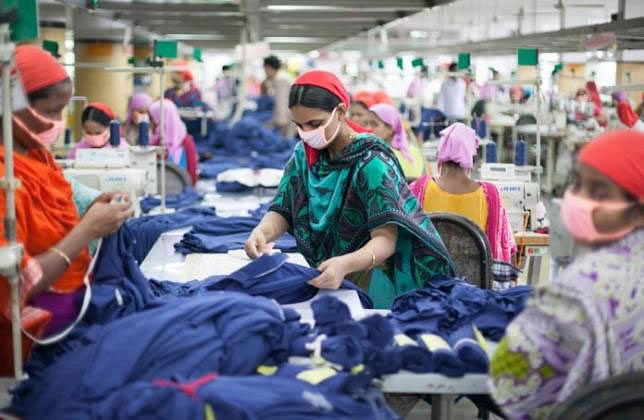Over half of export earning comes from five types of dresses

Around 61 per cent of Bangladesh’s export earnings come from five types of readymade garment (RMG) products -- trousers, jackets, t-shirts, sweaters and shirts.
At the same time, around 73 per cent market of RMG exports involve those five products. As a whole, the export of the country is dependent on these five types of dresses to a high degree.
The country earned $40.53 billion from exports in the fiscal 2018-19. Of that amount, the earning from the RMG sector was $34.13 billion. Around 72.95 per cent ($24.90 billion) of the that was from those five products.
Alongside the low-cost dresses, the country has also started production of value added products like suits, blazers, lingerie and swimsuits. But the market of those products is still not big enough.
Several entrepreneurs said the country's RMG sector had grown according to the wishes of the foreigners. This suggests the entrepreneurs have become unrivalled in producing low-cost dresses.
They further said that in the last few years, the production cost has gone up due to increase of workers' wage, price hike of gas and electricity and increased rate of interest of bank loans. This has put them under pressure and their margin of profit has decreased. To make the export sustainable, the businessmen must look for options beyond those five types of dresses. They must attract foreign investment, especially from China.
According to BGMEA (Bangladesh Garment Manufacturers and Exporters Association) t-shirt is the most exported item. The RMG companies earned $7.01 billion from this alone in the last fiscal year.
In the last five years, export of trousers has increased by $1.25 billion. Last year, $6.94 billion worth of trousers were exported, recording a 8.6 per cent increase than the previous fiscal.
The third highest exported product is jacket. For the past three years the export of jackets has been shooting up steadily. During the last financial year, jackets worth $4.38 billion were exported. The product was exported to the tune of $3.97 billion in the previous fiscal of 2017-18.
As a result, exports of the product have increased by 10.32 per cent in the past fiscal.
The exports of sweater have increased by 50 per cent in the last five years. While sweaters worth $2.82 billion were exported in the financial year of 2014-15, it increased to $4.25 billion in the last fiscal. This is 15.80 per cent higher than the previous year.
Export of t-shirts and sweaters has increased tremendously in the last five years but this has not been the case with shirts. Shirt exports have grown by just over $50 million during this time.
In the last fiscal, shirts worth $2.32 billion were exported, which was $2.06 billion in the previous financial year. It means a 12.62 per cent increase.
"The dependence on just five items is not good for the the garment industry," Classic Group managing director Shahidullah Azim told Prothom Alo on Thursday.
“In order to make export of readymade garments sustainable, export of cheap and high value products has to be equalised. Some of our entrepreneurs have started producing value added products. More foreign entrepreneurs have to be brought in to keep it up at a higher rate,” he added.
Shahidullah Azim also said, “China is invincible in producing diverse and value added clothing. Due to the ongoing trade war, many Chinese garment factories are shifting to different other countries, including Vietnam, Taiwan and Thailand. Only two of those are being made in Bangladesh. Our government must be more prompt in attracting Chinese investors.”
However, BGMEA senior vice president Faisal Samad said cheap clothing also has the opportunity to add value.
"Shirts, trousers, jackets, t-shirts and sweaters are our big assets. These products also have the opportunity to add value. Cheap t-shirts also become expensive through the use of diverse fabrics and designs. In addition to regular research on product development, we also have to track the market trend," he added.
*This report, originally published in Prothom Alo's print edition, has been rewritten by Farjana Liakat and Shameem Reza.